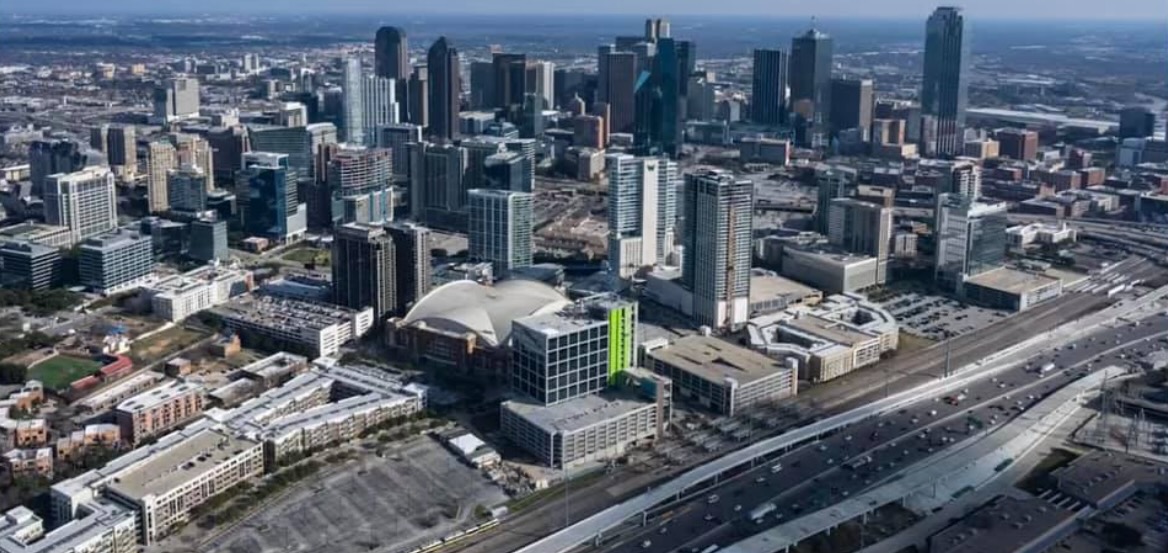Dallas Over the Years: A Skyline Evolution
Let’s delve into Dallas’ past, present, and future of development. What’s the origin story of the Dallas skyline and — perhaps most relevant for today’s residents, workers, and tourists — where is the city headed?

Click one of the links below to start exploring.
A Journey Through Time
Dallas made a name for itself in the early 20th century when oil brought bankers and financiers to its land. The city fast-tracked urbanization on the tails of the Great Depression and World War II, later becoming a hub for tech, healthcare, and more.
Dallas in the 1970s
Courtesy, Squire Haskins Photography, Inc. Collection, Special Collections, The University of Texas at Arlington Libraries.
Dallas City Hall was built in 1977 featuring a design by legendary Dallas architect I. M. Pei (Pei is also responsible for many other Dallas buildings, including One Dallas Center, built in 1979, now dubbed Patriot Tower).
Constructed in 1978, the Reunion Tower and its GeO-Deck is a Dallas icon that’s known affectionately by locals as “The Ball.” On the GeO-Deck, visitors can witness a 360-degree view of Dallas from 470 feet in the air. Welton Becket designed the structure as well as its neighbor, the Hyatt Regency, which was built the same year.
The Hyatt was immediately indelible to the Dallas scene, so much so that it earned a spot on the intro for the TV show “Dallas,” which first aired the same year. The 1,000-room hotel was a product of the Hunt oil empire.
Dallas in the 1980s
Courtesy, Squire Haskins Photography, Inc. Collection, Special Collections, The University of Texas at Arlington Libraries
The Dallas skyline changed dramatically in the 1980’s.
In 1985, the Bank of America Tower reached the end of construction to become what would remain the city’s tallest skyscraper today. Most notably, the building features a green LED outline at night.
In 1986, Dallas got what is arguably its most iconic building: Fountain Place. The skyscraper — today the fifth-tallest in Dallas — is enveloped in mirrored glass that, at certain vantage points, causes the structure to disappear into the sky’s reflection. But from a widened view, the building does anything but disappear among the masses. Instead, it stands out. Architects Henry N. Cobb and I. M. Pei worked with developers Bill and Sheri Criswell to bring the building to fruition as a home for high-end offices, which today functions the same.
While Cobb’s original vision for Fountain Place consisted of two identical towers, the city did not see another structure alongside the original for 30 years.
In 1987, construction finished on the Comerica Bank Tower, which was originally dubbed Momentum Place. The building’s original occupant, MCorp Bank, dissolved shortly after the building was constructed amidst an economic downturn. It wasn’t until 2007 that Comerica announced it would purchase the building, occupying it alongside other commercial tenants.
That same year, the Chase Tower (designed by Skidmore, Owings & Merrill) was constructed and became what is now Dallas’ fourth-tallest building. This building is nicknamed the “Keyhole Building” because, in addition to a curved glass top, it features a six-story hole in the center of the building near the top.
The Morton H. Meyerson Symphony Center came to life in 1989, ushering in a new era for arts with a bold circular design.
Dallas in the 2000s

Remember Fountain Place from the 1980’s? In late 2020, it got its partner, AMLI Fountain Place, a residential counterpart to the original commercial skyscraper. Meanwhile, the original tower went through renovation to bring it into the modern day.
In 2009, Dallas enlarged its artistic presence with the Winspear Opera House, designed by Foster + Partners Architects, which features a stunning retractable facade and environmentally friendly cooling structural design.
Just a few years later in 2012, the Margaret Hunt Hill Bridge connected two sides of the Trinity River right alongside the pedestrian Ronald Kirk Bridge. The bridge features a signature 40-story center-support arch that can be seen for miles.
In 2019, Dallas lost two historic structures, changing its development in a different way. After 115 years, the Ambassador Hotel building burned down in a fire. And demolition crews imploded the Reserve Life Insurance building for new construction.
Even with these losses, the city’s growth in recent decades more than makes up for them.
Looking Ahead: A Maturing Dallas

The Dallas skyline is still evolving with new projects.
Dallas is in the midst of developing its Field Street District, which aims to “transform the concrete parking lots of today into a vibrant, green neighborhood.” Situated between the Dallas World Aquarium and Perot Museum, this mixed-use area seeks to connect six city neighborhoods through two high rises over six acres in a $1 billion project.
Another mixed-use development in the works is called Newpark, which refers to itself as a “smart district.” The landmark, 1 Newpark, is a “hyper-mixed-use tower” directly across from the Dallas Convention Center and Dallas City Hall. Lanoha Real Estate, KDC, and Hoque Global are partners in the project, which will feature retail, hospitality, office, and residential spaces.
Meanwhile, the Kay Bailey Hutchison Convention Center Dallas is expanding via a $3 billion project that will tear down and replace the existing facility with a 2.5 million square-foot convention center. The project will connect downtown to surrounding neighborhoods to the city’s south using an innovative deck park.
Over in southwest Dallas, atop a decommissioned naval air station on Mountain Creek Lake, lies the future Hensley Field. The area is poised to become a 738-acre mixed-use community with residential units, waterfront trails, and even a marina (just to name a few of the proposed amenities).
Ultimately, all of these changes to Dallas will change its skyline, but the community itself is poised to evolve as well. From 2020–2023, the Dallas-Fort Worth area grew in population by 5.7%, leading the nation in new residents. It’s also a big tourist destination, with more than 25.7 million people visiting the city every year (and spending $6 billion while they’re there).
All of this is to say that Dallas is a maturing city with growth on the horizon, and the team at Built cannot wait to see how the city evolves.
Who is Built?
Built Technologies was founded in 2014 with an idea to improve connectivity and transparency among all stakeholders in the construction & real estate finance process. Given Dallas’ continuing evolution, our interest and involvement in the burgeoning city comes naturally. Since then, our software has had the privilege of partnering with 98 financial institutions in Texas that have processed $57 billion in commitments on the Built system. Of that, $3.3 billion was in the Dallas area alone, with nearly 97% — or $3.2 billion — processed in the last five years, highlighting our accelerating impact. Today, nearly half of the top 100 construction lenders in the U.S. use Built software, and a quarter of a trillion in real estate dollars are actively managed on its platform.
Want to simplify your construction payments process?
Connect to your favorite accounting, project management, and banking platforms.









